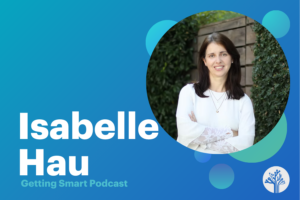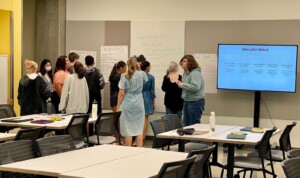Getting to Know Stuart Udell: Q&A with New K12 Inc CEO

In early 2016, K12 Inc. named Stuart Udell as the company’s new Chief Executive Officer. Change in leadership can bring new energy and awareness to any company, which is why we are excited to hear more from the new CEO.
We had the chance to ask Stuart a little bit about his past as well as his hopes for the future with K12. We learned a ton, from how digital learning can positively impact the dropout problem and provide new solutions for students to how K12 is embracing predictive analytics to inform instruction and move towards better personalization.
Q&A With Stuart Udell
Q: You have served 13 years on the board of the National Dropout Prevention Center. How has your involvement in this organization shaped your views on education?
A: My work with the National Dropout Prevention Center has most importantly taught me that choice–having appropriate options and alternatives–is critical to meeting the diverse needs of students who are at risk of dropping out of school. Research shows that students who drop out are influenced by a wide range of risk factors, and that the act of dropping out is usually not the consequence of any one particular event but rather a long process of disengagement. Thus, placing a recovered student back into the same environment, classroom and teaching modality will generally not prove successful the second time around.
Educational technology is not surprisingly one of the National Dropout Prevention Center’s core fifteen research-based strategies that has been shown to positively improve graduation rates. This digital learning strategy, particularly as deployed in virtual schools, has worked so well with at-risk students because it successfully embeds several other proven dropout prevention strategies such as individualized learning, mentoring and tutoring, safe learning environment, alternative schooling and family engagement. K12 was pleased to recently announce that it will be further supporting dropout prevention research with its production partnership of the National Dropout Prevention Center’s television and webcast series, Solutions to the Dropout Crisis.
Q: You built an impressive resume as a leader in the education industry before joining K12 as the CEO. What motivated you to join K12?
A: I was motivated to join K12 because of a passion that I share with thousands of team members in K12 and our partner schools – to make a difference in meeting the individualized and personalized educational needs of underserved students, regardless of their circumstances. My grandmother was a teacher and my mother was an administrator in my school district, so it’s not surprising that I have spent the vast majority of my career focused on trying to make a difference through instruction.
While in and of itself great curriculum and technology are certainly essential, the teacher is the key. Real change happens when the classroom door closes, whether it be a physical or virtual classroom door. K12 is in essence a teaching and learning organization; a provider of world-class technology-enabled curriculum and instruction to students in managed and partner public schools as well as private schools. We have built a platform that truly allows teachers to be great and, as our mission says, to maximize every child’s potential by transforming the educational experience. I joined K12 to help make a difference in this way.
Q: Online learning has faced many challenges and critics. It is has also had great achievements and made real strides in changing education. What are the key areas that online education leaders need to focus on to overcome the challenges and build on the successes?
A: Online learning has been a disruptive force in education, and much of the credit goes to the early pioneers who advanced the idea that quality learning is only confined to the traditional system. Yet we must remember that online education is still relatively young, and as is often the case with new innovations, we are learning valuable lessons from the successes and failures. One of the biggest challenges in online learning is student engagement. Certainly that is a challenge in every model of education, but it is particularly acute in online schools. So we need to ask the right questions:
- Are we developing content and academic programs that are sufficiently engaging to students?
- Can we create new, differentiated instructional approaches that make learning more interesting to today’s students?
- What is required to improve the overall learning experience in ways that drive up the levels of student engagement?
Then we need to listen to the school leaders and teachers who are working with students in schools every day and rely on their input and wisdom. Finally, we need to be bold and take action to invest in new programs, test new concepts, launch new initiatives, provide new tools/support to teachers and do what is necessary to improve outcomes. That is what we are doing at K12.
Q: What are your top priorities at K12 and your goals as CEO?
A: Certainly our number one priority will be to continue to build upon the educational experience and drive successful student outcomes. The good news is that much of the groundwork has been laid and tremendous progress has been made by my predecessor, Nate Davis, who has remained with K12 as Executive Chairman. This succession and continuity in leadership is important because some great programs have been deployed over the last couple of years, most notably our Students First initiative.
Students First is a systemic approach to continuous educational improvement, encompassing significant investments to ensure that students start out strong in a new learning environment and stay on track with ongoing family and student supports. We have similarly increased resources and professional development programming for teachers and school leaders. We are investing substantially in our next generation learning platform and courses, which will redefine best-of-breed in learning technology and begin to roll out this fall. Lastly, we will continue to diversify our service modalities, reaching students not only through our managed public school offerings, but also through our private school options and partnerships with public school districts.
Q: K12 has launched a number of new initiatives. Can you tell us a little bit about what K12 is doing and what is next?
A: An exciting area of focus for K12 is serving both students and local economies through our new Career Technical Education programs. Creating highly relevant educational alternatives linked to career pathways is a proven practice, with an average high school graduation rate for students concentrating in Career Technical programs at 93 percent, or 13 percent above the national average. And when these students “stack” a related Career Technical associate degree or credential on top of a high school diploma, they can on average earn $4,000 to $19,000 more per year than a person with an associate degree in the humanities.
Our new partner virtual career academy in Wisconsin, recently launched in cooperation with a local trade union, represents the first of several Career Technical offerings planned by K12 this year. We’ve already built the curriculum and have planned a significant expansion of these programs over the next three years, with focused career pathways leading to industry-recognized certifications in business, health sciences, information technology and manufacturing.
K12 has also recently released programs to address one of the most significant issues facing public schools in the United States–the need to appropriately support English Language Learners (ELLs). Today, these students represent the fastest growing segment of the public school population, and by 2025 nearly one out of every four public school students is expected to be an ELL. The market for ELL programs in grades K-12 is estimated to be $900 million and is growing at a double-digit pace. Our new ELL programs offer schools virtual and blended options to address this very real student need, and I’m excited to say that the initial interest is very promising.
Looking forward, as one of the true pioneers of the digital education revolution, we find ourselves again at the beginning of a new phase–one with the promise of impacting student outcomes by providing more tools to teachers and more choice to parents. K12 is forging forward in predictive analytics, adaptively using data to inform instruction and move instruction towards true personalized learning and support.
We are in a unique position in the industry with over 100,000 students attending our partner schools, in which we are able to draw from large and complex data sets to improve instruction, engagement and persistence. This school year we will be rolling out the first phase of our next generation curriculum and technology platform with embedded real-time analytics and predictive functionality. This evolution to more adaptive digital education will undoubtedly yield a more engaging and personalized student experience, but also enhanced student outcomes.
Former CEO, Nate Davis, who transitioned into the role of Executive Chairman, notes that:
“Stuart is an exceptional leader and educator, passionate about our mission, and committed to providing effective, next generation educational opportunities for children. His depth of experience and track record of success in education uniquely qualifies him to lead K12 and continue the progress we’ve made in improving academic outcomes, and preparing a new generation of students to succeed. Stuart will be a welcome addition to our team and together we will continue building a great education company.”
Udell will be will be speaking at the upcoming ASU-GSV conference on Monday, April 18th at 2:00pm on the panel: Delivering on the Promise of Personalized Learning and Nate Davis will give K12’s Company Presentation on Monday at 9:00am.
For more, see:
- K12 will be Launching Destinations Career Academies
- Getting Smart Podcast | Progress and the Path Forward for Digital Learning
- The Shift to Digital Learning: 10 Benefits
Stay in-the-know with all things EdTech and innovations in learning by signing up to receive the weekly Smart Update. This post includes mentions of a Getting Smart partner. For a full list of partners, affiliate organizations and all other disclosures please see our Partner page.






0 Comments
Leave a Comment
Your email address will not be published. All fields are required.